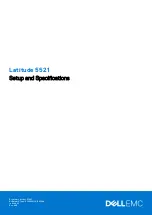
35
Parameters
(Media)
Description
Default Value
1. RTP Port Range
This specifies the range of RTP port to be used for audio stream.
16384 - 32768
2. Packet length (ms)
This specifies the length (in time) of each packet. However, the packet length is codec
dependent as well. The minimum packet length of a codec supersedes the valued
specified here. The table below summarizes the possible packet length for the codec
supported.
Codec
Time / Frame (ms)
Time / Packet
(ms)
G.711 a-law /
-law
0.125
G.729, G.729A,
G.729AB
10
10, 20, 30
G.723.1
30
30, 60
20
3. Jitter Buffer
Delay
Min. Delay (ms)
Max. Delay (ms)
A jitter buffer is designed to remove the effects of jitter from the decoded voice stream,
buffering each arriving packet for a short interval before playing it out. This substitutes
additional delay and packet loss (discarded late packets) for jitter.
If a jitter buffer is
too small then an excessive number of packets may be discarded, which can lead to call
quality degradation. If a jitter buffer is too large, then the additional delay can lead to
conversational difficulty..
A fixed jitter buffer maintains a constant size whereas an adaptive jitter buffer has the
capability of adjusting its size dynamically in order to optimize the delay/discard
tradeoff.
Three modes of jitter buffer are supported:
1. Fixed - The fixed mode, which is the default mode, is a simple first in first out
mode, with a fixed jitter buffer delay.
2. Sequential - The sequential mode is also a fixed jitter buffer delay mode, but in
this mode the jitter buffer function looks at the packet timestamp for dropped or
out of sequence packet problems. The data packets are sorted based on the
packet timestamp
3. Adaptive - The adaptive mode optimizes the size of the jitter buffer delay and
depth in response to network conditions, in addition to the sequential mode
functions.
This specifies the fixed jitter delay for both Fixed and Sequential Jitter Buffer mode.
This specifies the minimum jitter delay for Adaptive Jitter Buffer mode.
This specifies the maximum jitter delay for Adaptive Jitter Buffer mode.
Fixed
60
4. Media QoS
Similar to Signaling QoS, this parameter enables the QoS property for audio packets.
Both IP ToS (Type of Service) and DiffServe (Differentiated Service) method are
supported
.
None
5. Media Encryption
Similar to Signaling Encryption (item 6 in this table), this parameter enables the
encryption for audio packets. Encryption methods supported are RC4 and ET263.
None
6. Symmetric RTP
Network environment in some enterprise may require Symmetric RTP. Please check
with your network administrator for further support.
Disabled
(not
selected)
7. Media NAT Traversal
This setting is not required if the target SIP server / PBX supports NAT traversal.
However, if your ISP blocks VoIP traffics, you could try to use Relay Proxy setting.
Depending on how your ISP blocks VoIP traffics, the Relay Server method may or may
not work in your network environment.
Two NAT Traversal methods are supported:
1. Stun Server – An external Stun Server is required. This allows the device to
obtain the public IP of the network used.
2. Relay Proxy – Enter the IP address or the domain name of a Relay Proxy. Please
contact technical support for further assistance.
None
Содержание GoIP
Страница 26: ...26 ...
















































